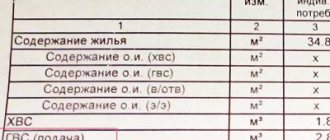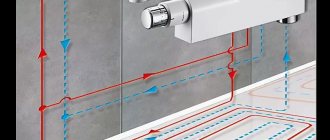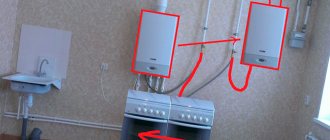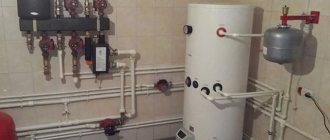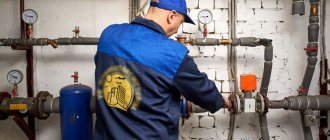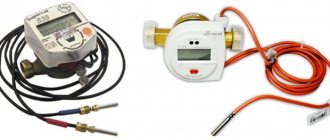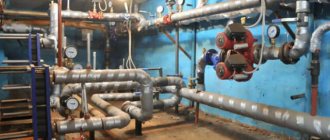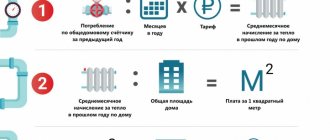When looking at a receipt for payment of housing and communal services, we do not always notice the appearance of new lines, especially if the cost of a particular service is not too high. We are more interested in the final accrual. The more resources are used, the larger the amount to be paid.
Residents of apartment buildings use many energy resources - electricity, water, heat. As a result, a receipt is generated, from which it is clear how much you need to pay for the services. There is another line - UUTE, which causes confusion among people. Personally, I called the Criminal Code and cursed about this. Unfortunately, until I myself clarified what was going on, I did not receive reliable information from the utility workers. As a result, this article was written, where everything is set out in as much detail as possible.
What is UUTE in a housing and communal services receipt?
To begin with, I’ll tell you that UUET stands for heat energy metering unit. In fact, this is a whole system of measuring instruments and devices that monitor and help calculate the amount of resource consumption. The term appeared and was approved several years ago in PP-1034 dated November 18, 2013.
It is important to note here that the installation of UUEET is carried out without taking into account the wishes of the residents. This procedure is the responsibility of utility companies, which is clearly stated in Russian legislation. The difficulty lies in the fact that all financial expenses fall on the shoulders of the residents, and with them a corresponding line appears in the receipt.
Maintenance of UUTE
All responsibilities of the service provider are specified in the contract. The performing company is obliged not only to install the equipment, but also to carry out its maintenance. The UUTE maintenance includes the following activities:
- External inspection is carried out once a month. The main task is to check the integrity of the sealing, fuses, safety of connecting cables, checking grounding;
- metering devices must undergo not only inspection, but also a number of technical actions, such as cleaning filters, checking the operation of electromechanics, automation, wiring integrity, adjusting the operation of the metering system;
- metrological checks are carried out periodically at a special stand in the laboratory. The purpose of the event is to maximize the life of the equipment;
- interaction of work with the organization supplying heat.
The cost of these services is fixed in the contract and cannot be changed throughout the entire period of the contract.
For what purpose is the meter installed?
Not all residents of an apartment building understand why installing such a device in their house, but employees of the utility company assure that it is beneficial and over time the benefits will become obvious. Housing and communal services employees cite the following reasons for installing equipment:
- UUTE provides accounting of consumed resources in a particular home. In the event of heat loss on the main line due to the fault of the supplier, the losses are written off specifically from the company, and not from the consumer. In addition, only actual resource expenditures are taken into account.
- Residents have the opportunity to control the quality of resources, that is, heat. Apartment owners will be able to make sure that they receive all consumed resources in the paid volume.
- The devices allow you to record the period of shutdown of hot water supply. That is, the time when only cold water costs should be taken into account.
If the system is old, then it may well be necessary to modernize or remove some of the old structures. This increases the financial burden on the homeowners in the house, and with it the amount of the issued receipt also increases.
Replacement of thermal energy metering units
If a heat metering unit is installed in the house, there seems to be nothing to worry about, but sooner or later the time comes when it needs to be replaced or modernized. This may be due to technical indicators, worn-out equipment, or the fact that the installed UTE no longer meets regulatory requirements.
Of course, modernization is much cheaper, because in this case one of the components, the heat meter, is replaced without dismantling the entire system. Also in this case, there is no need to obtain technical specifications for installation or develop a new project. Upon completion of the work, a new commissioning certificate and a new contract are drawn up.
How much can it cost to install UTE in an apartment building?
Many homeowners are concerned about the question of why they should pay for the installation of UTE and how much it can cost. The problem is that the cost of installing the equipment is not very low. It consists of the cost of the equipment itself and the cost of installing the devices. An important point is the condition of the pipeline.
On average, installation of equipment can cost residents of an ordinary building with 100 apartments about 60-300 thousand rubles. It depends on the prices for the devices themselves and their installation. Disputes have repeatedly arisen regarding the legality of such actions, but the law very clearly states that all costs of maintaining the house are paid by the residents.
Legislative acts stipulate that residents of a building have the right to independently take care of installing a heat metering unit, but this is only possible if there is a positive decision at a general meeting of apartment owners. In simple words, people must vote for it and then raise money to carry out the necessary work. If the HOA has enough money, the line will not appear on the housing and communal services receipt. By entrusting the management company with the work, residents have the right to expect payment in installments over a period of five years.
Who generates receipts for housing and communal services payments?
There are several aspects to consider when answering this question. Thus, according to the law, in an apartment building, receipts for payment of utility services are sent and generated by management organizations. They are authorized to calculate the consumption of the following housing and communal services:
- for water supply;
- per apartment (depending on the number of persons registered there);
- for major repairs, etc.
Citizens receive separate receipts for gas and electricity supplies. This is due to the fact that these organizations are direct suppliers of utility services, and therefore charge directly.
What are the responsibilities for installing UUTE?
Installation of equipment is considered the responsibility of the premises owners. Evasion from fulfilling this obligation is regarded as a violation of the law, which means it is subject to serious punishment.
First of all, representatives of the management company or HOA should notify residents of the need to install a metering unit. If after this no action was taken, then the residents of the house will face litigation. As a result, the court will still decide to comply with this requirement. When a tenants' association, management company or resource supplier is to blame for the lack of UTE, fines of up to 100-150 thousand rubles are provided for a legal entity and up to 20-30 thousand rubles for an official.
Heat meter functions
Any type of device must perform the following tasks:
1. Automatic measurement:
- Duration of work in the error zone.
- Operating time with supply voltage applied.
- Excessive pressure of liquid circulating in the pipeline system.
- Water temperatures in pipelines of hot, cold water supply and heat supply systems.
- Coolant flow in pipelines and heat supply.
2. Calculation:
- The amount of heat consumed.
- The volume of coolant flowing through the pipelines.
- Thermal power consumption.
- Differences in the temperature of the circulating fluid in the supply and return pipelines (cold water supply pipeline).
Installation Features
Installation of a heat metering unit in an apartment building is divided into several main stages:
- Study and analysis of the object.
- Creation and approval of the project.
- Assembly and adjustment.
- Organization of monitoring.
- Providing a diagram of the heating unit of an apartment building to the heating supply organization and obtaining an operating permit.
The cost of the procedure depends on the characteristics of the object and can vary significantly. If it is necessary to replace the thermal energy metering unit, the sequence of actions is approximately the same. The most critical stage is the development of the project and selection of equipment. Naturally, the installation of thermal energy metering units must be carried out with maximum care and precision. However, if the initial calculations turn out to be erroneous, even high-quality, expensive devices will not provide the required accuracy of readings.
When a heating unit is installed in a private house, the coordination scheme may be slightly different. In any case, going through the authorities on your own will require serious time investment. As a rule, the installation of thermal energy metering units includes this service. Decide for yourself what is preferable to you - pay a little extra or save through your own efforts. However, keep in mind that it is much easier for experienced representatives of a construction organization to obtain permission than for an individual.
Automation of heat metering units makes it possible to organize remote data collection from meters, which greatly simplifies facility monitoring. UUTE maintenance should be trusted to professionals. Independence in this matter, as in the installation of heat metering units in Moscow, can lead to significant financial losses. If equipment breakdown is not noticed in time, repairs may take a long time, and all this time you will be overpaying for unused heat. If you are interested in whether it is possible to install UUTE on the heating unit of your home and other questions on this topic, you can get answers to them on our website.
Hello!
Short
Apparently, the heat meter was installed by Heating Network in accordance with Part 12 of Article 13 of the Federal Law of November 23, 2009 No. 261-FZ, and in accordance with paragraph 38(1) of the Decree of the Government of the Russian Federation of August 13, 2006 No. 491 cost on receipt.
The management company had to hold a general meeting at which the owners should decide to increase the tariff for current repairs and maintenance of common property by the amount necessary to service the heat meter.
This was not done. The management company does not deal with the heat meter, since the costs for it are not included in the estimate.
You need to conclude an agreement with the same “Heating Network” (or another company - if desired, “Heating Network” does not have the right to refuse to conclude this agreement) for its maintenance.
If the meter breaks down, a 3-month fee is charged based on the average consumption for the heating period, and then according to the standard.
Details
According to paragraph 5 of Article 13 of Federal Law No. 261-FZ of November 23, 2009, owners of residential buildings or premises in multi-apartment buildings are required to ensure that such houses are equipped with both collective (common house) and individual (with the exception of heating) with metering devices (until January 1, 2015, with natural gas metering devices).
In accordance with paragraph 5 of the Rules for the maintenance of common property in an apartment building, approved by Decree of the Government of the Russian Federation of August 13, 2006 No. 491, a common house meter refers to common property, the acquisition and installation of which is carried out at the expense of the owners, in proportion to the share in the right of common property for common property in this house. Installation of individual metering devices in residential premises is carried out by the owner of the premises at his own expense. If the owners of premises in an apartment building have not independently ensured that such a house is equipped with common building meters for metering the utility resource used, then in accordance with Part 12 of Article 13 of Federal Law No. 261-FZ, the resource supplying organization is obliged to do this by July 1, 2013. The owner is obliged to reimburse the costs of installing a common house metering device for the specified organization in the amount proportional to his share in the right of common ownership of common property, in accordance with paragraph 38 (1) of the Decree of the Government of the Russian Federation of August 13, 2006 No. 491. The owners of premises in the apartment building pay the costs of the RSO equal in installments over a period of five years from the date of installation of the meters, provided that they do not express their intention to pay such expenses in a lump sum or with a shorter installment period. In accordance with paragraph 38(1) of the Decree of the Government of the Russian Federation of August 13, 2006 No. 491, property owners are required to pay the costs of installing a collective metering device on the basis of an invoice issued by RSO (if the corresponding amounts were not taken into account as part of the fee for the maintenance and repair of residential premises and (or) as part of mandatory payments and (or) contributions established for members of the HOA). Moreover, the RSO must indicate in the invoice for each owner both the total amount of expenses for installing the metering device and the share proportional to the share in the right of common ownership of the common property to be paid by this owner.
In case of “breakdown” of the heat meter.
59. Payment for a utility service provided to a consumer in a residential or non-residential premises for the billing period is determined based on the calculated average monthly consumption of the utility resource by the consumer, determined by meter readings for a period of at least 6 months (for heating - based on the average monthly consumption for the heating period volume of consumption), and if the period of operation of the metering device was less than 6 months, then for the actual period of operation of the metering device, but not less than 3 months (for heating - at least 3 months of the heating period) in the following cases and for the specified billing periods: a )
in case of failure
metering device
previously put into operation or the expiration of its service life, determined by the period of time before the next verification - starting from the date when the specified events occurred, and if the date cannot be determined , - then starting from the billing period in which the specified events occurred until the date when the accounting of the utility resource was resumed by putting into operation an individual, general (apartment), room metering device that meets the established requirements, but no more than 3 billing periods in a row for a residential premises and no more than 2 billing periods in a row for non-residential premises;
Every home owner is faced with the need to pay for utilities. In order to have water, gas, electricity, heat and other amenities in the apartment, you have to fork out a significant amount every month. Many residents try to reduce payments as much as possible by installing individual meters that record water and gas consumption in a specific apartment. But apparently, the native state does not plan to make life easier for citizens.
Proof of this is the legislative enshrinement of the obligation to pay for the installation of a single heat energy meter in your home. What is it, what is it for, is it possible to refuse to install it and who is it useful for? The article contains answers to all questions.
Dear reader! Our articles talk about typical ways to resolve legal issues, but each case is unique.
If you want to find out how to solve your particular problem, please use the online consultant form on the right or call.
It's fast and free!
Use of UTE for property owners in relation to heating payments
After installation of metering devices, payment is made during the period of provision of the relevant services. The length of the heating season varies depending on the season, but on average it is about 7 months. You do not have to pay for the whole year, but during the provision of services.
Until the installation of UTE, payment for heat supply is charged according to accepted standards, which for homeowners is associated with a significant increase in payments. The use of devices for recording the supplied resource allows you to save money for payers.
At the legislative level, the responsibility of a management company that has not taken sufficient measures regarding the need to install a heat meter is established. The fine is:
- for organizations – up to 150 thousand rubles;
- for officials – up to 30 thousand.
There are also administrative fines for public utilities who unreasonably refuse to use UTE in comparable amounts to those indicated above.
If residents refuse to install the device, they will be required to do so by court order, according to the statement of claim filed by the utilities. Additionally, you will have to reimburse court costs and pay the assigned fine.
The use of UUTE allows property owners to obtain obvious advantages, similar to the situation with the use of any other metering devices. And the necessary initial costs for the purchase and installation of equipment will definitely pay off, due to the subsequent reduction in costs for paying for the supply of heat.
Basic diagrams of heating systems
So, before considering the diagrams of thermal units, it is necessary to consider what types of heating system diagrams there are. Among them, the most popular is the top distribution design, in which the coolant flows through the main riser and is directed into the main pipeline of the top distribution. In most cases, the main riser is located in the attic, from where it branches into secondary risers and is then distributed to the heating elements. It is advisable to use a similar scheme in one-story buildings in order to save free space.
There are also diagrams of heating systems with bottom wiring. In this case, the heating unit is located in the basement, from where it comes out with warm water. It is worth noting that, regardless of the type of circuit, it is recommended to also place an expansion tank in the attic of the building.
Types of heat meters depending on the measurement method
Currently, the following types of heat meters are widely used:
- Mechanical operating principle or tachometer. The most common modification of heat metering devices. There are vane or rotor (turbine) ones. Quite easy to use and does not require electrical costs. They work thanks to an impeller or rotor and reciprocating fluid movement;
Important! Mechanical heat meters are demanding of the coolant; the water must be clean. The device is equipped with an additional filter element, since its contamination directly affects the accuracy of the readings.
- Electromagnetic. The operating principle is based on interaction with electric waves of the coolant. Of all the presented categories, these metering devices are the most accurate. The disadvantage of the device is its use in horizontal thermal systems;
- Ultrasonic. Thermal energy is measured by measuring the length of the ultrasound signal passing through the coolant. The meters are installed in pairs, opposite each other. They also differ from each other according to: frequency, time, correlation and Doppler principles of operation. Used in open and closed thermal systems;
- Vortex type. They create a vortex flow in the liquid, due to their location on the path of coolant movement, with subsequent recording of the formation and disappearance of magnetic field vortices. It is used in vertical and horizontal heating systems.
Important! Vortex heat meters require straight pipelines, since the quality of measurements directly depends on the composition of the moving hot liquid, its speed and the presence of air masses in it.
What does a utility bill look like?
What does a utility bill look like?
A housing and utility bill looks like this: it is a written document that lists the services for which a fee is charged. Tariffs are also indicated there.
The rent act has the following content:
- Indication of the payer.
- Address and location of residential premises.
- The name of the service provider and its bank details.
- QR code.
- Data on the services provided.
- Tariffs that are applied during calculation.
- Total amount to be paid.
Depending on the management company, the receipt may also include services for garbage removal, sewerage, general house needs, heating, etc.
